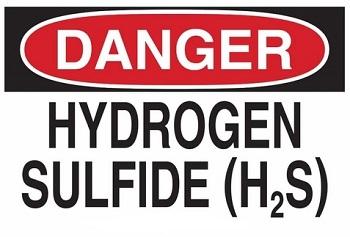The effects of hydrogen sulfide (H2S) depend on its concentration in the air, the exposure duration, and the health of the person exposed. Hydrogen sulfide is part of the environment and many people are exposed to it without any danger because typically the environmental concentration of the gas in the air is only 0.00011-0.00033 ppm (parts of hydrogen sulfide per million parts of air by volume). In fact, hydrogen sulfide is produced in the human intestines as part of the digestive process. Then, it is released as one of the gases that give the offensive smell to flatulence and to bad breath or halitosis. It is safe to say that no one has died from inhaling flatulence or bad breath because they contain only 0.001 to 1 ppm hydrogen sulfide. However at 10 to 20 ppm, various health issues are observed, at 100ppm and higher, H2S is considered “immediately dangerous to life and health (IDLH) and at 500 ppm and above, death can be immediate.
At higher concentrations, this rapidly-acting, colorless and poisonous gas is also corrosive, flammable, and explosive. It is considered a silent health, safety, and environmental threat because without measuring instruments, it can be undetected by the people who are exposed to it. Although it is often described as a gas with a rotten-egg smell, exposure to high levels of H2S can desensitize a person’s sense of smell. Odor is not a reliable warning of the presence of hydrogen sulfide.

Dangers to Health
When you’re exposed to hydrogen sulfide through inhalation, eyes, or skin contact, it is absorbed into the bloodstream and circulates in the body. That’s why various symptoms related to the respiratory, cardiovascular, ocular, and neurological systems are observed after exposure to hydrogen sulfide.
Respiratory System
One of the major dangers of hydrogen sulfide at high concentrations is that it is an asphyxiant or a substance that reduces the oxygen-carrying capacity of the blood. The lack of oxygen may cause asphyxiation (suffocation) and eventually death unless the exposed person is immediately moved to where fresh air is available or artificial respiration is performed.
Other respiratory problems include but not limited to sore throat and nasal passages, respiratory tract irritation, and pulmonary edema, or fluid buildup in the lungs.
Ocular System
Eye problems may include irritation, tearing of the eyes, itching and painful eyelids or “gas eye”, light sensitivity and ‘seeing rainbows” when looking at bright lights. Direct eye contact with compressed, liquefied hydrogen sulfide can cause permanent damage or blindness.
Neurological System
Neurological problems may include headaches, fatigue, tremors, convulsions, delirium, poor memory, irritability, olfactory paralysis or loss of the sense of smell, dizziness and loss of consciousness.
Cardiovascular System
Cardiovascular problems may include higher blood pressure, chest pain, and other cardiac irregularities.
Skin Contact
Direct contact of the skin with compressed liquefied hydrogen sulfide causes numbness, itching, and prickling which are symptoms of mild frostbite or “blue skin”. Stiffness and a burning sensation are symptoms of severe frostbite.
Frostbite makes the skin appear waxy white or yellow. Severe frostbite may cause infection and tissue death.
Dangers to Safety
Hydrogen sulfide is a flammable and explosive gas. It’s so flammable that it can burn even at a distance from the source of ignition. Burning hydrogen sulfide produces sulfur dioxide which can cause serious injury to the eyes and lungs.
This gas also forms an explosive mixture with air at room temperature but at a concentration of 4.3 (43,000 ppm) to 46% (460,000 ppm) which is much higher than the OSHA PEL.
Danger to Microelectronic Devices
Hydrogen sulfide in the environment corrodes silver and copper which are commonly found in microelectronic devices that are used in many pieces of equipment. Corrosion may form an insulating layer on the metal contact surfaces and cause reduced reliability and even functional failure of the devices.
Who is at risk?
Since hydrogen sulfide at harmful levels may not be detected by human senses, it is important to identify the places where the gas is most likely to exist. The people who work or live in those areas are at risk of exposure to hazardous levels of hydrogen sulfide.
Natural sources of hydrogen sulfide
Hydrogen sulfide is produced naturally in swamps, waste landfill sites, sewage sludge, liquid manure, sulfur hot springs, some mineral rock in mine tunnels and other places where there is decaying organic matter in the absence or lack of oxygen. That’s why it’s also called sewer or swamp gas.
So, workers entering a drainage ditch or excavating in landfills should be aware of the possible presence of high concentration hydrogen sulfide in the working areas.
Owners of houses and buildings near the natural sources of hydrogen sulfide should bear in mind that the gas is heavier than air and may accumulate in confined or poorly-ventilated, low-lying areas like their basements.
Industrial sources of hydrogen sulfide
Some of the industrial sources of hydrogen sulfide include the drilling and refining of crude oil and gas, wastewater treatment, iron smelters, production glue, dye, pulp and paper.
Other industries store hydrogen sulfide which they use in metallurgy and to make other chemicals, pesticides and pharmaceutical products.
How to avoid the dangers of hydrogen sulfide
The dangers of hydrogen sulfide can be avoided by following the established protocols. The workers and all people who can be potentially exposed to the hazardous levels of the gas should be educated or trained to implement the following:
1. Proper detection and monitoring
There should be a required schedule to monitor hydrogen sulfide levels using regularly calibrated measuring instrument. Don’t use the smell of hydrogen sulfide as a basis to determine H2S concentration in the area.
2. Act on warning signs of H2S gas
Workers and other people in the area should not take for granted irritated eyes, breathing difficulties, nausea, and other signs or indicators of the possible presence of hydrogen sulfide. Apply the appropriate first aid treatment and other required immediate action.
3. Implement applicable engineering controls
Engineering controls which may differ according to the specific requirements of the place may include:
- exhaust ventilation to maintain H2S concentration below the permissible exposure level (PEL).
- enclosure of the process which emits H2S to prevent its release into the workplace.
- regular checking and maintenance of pipes, valves and containers used for H2S.
- proper storage area for hydrogen sulfide.
4. Warning signs
Post strategically located “No Smoking” and other warning signs.
5. Emergency plan training
Provide adequate training and dry run on the emergency plan that includes procedures, location of emergency equipment, appropriate first aid treatment, escape route, and safe areas.
6. Use of appropriate personal protective equipment (PPE)|
According to the OSHA PPE Standard, it is the employers who will determine the appropriate PPE for their use. Some PPEs include safety goggles, face shield and respirators, gloves and boots. The material should be resistant to penetration and degradation by H2S.
7. Comply with exposure limits
Employers and employees should both be aware and comply with the PEL for hydrogen sulfide
Federal Government Regulations
The government protects the public by regulating toxic substances like hydrogen sulfide through the U.S EPA, the Occupational Safety and Health Administration (OSHA), the Food and Drug Administration (FDA), and other government agencies. The OSHA has set the following permissible exposure limits (PELs) or the concentration at which workers can be exposed daily without harmful effects.
- 20 ppm as the General Industry Ceiling Limit, not to be exceeded at any time.
- 50 ppm as the General Industry Peak Limit for a 10-minute maximum exposure
- 10 ppm as the limit for 8-hour exposure in the construction and shipyard industries.
The National Institute for Occupational Safety and Health (NIOSH) recommends an exposure limit of a 10-minute ceiling for 10 ppm concentration level. The research and educational institution has also determined that 100 ppm is immediately dangerous to life or health (IDLH) to exposed persons.
The Agency for Toxic Substances and Disease Registry (ATSDR), a public health agency, provides more information about the dangers of hydrogen sulfide.
The recommendations from NIOSH and ATSDR are advisory only but regulations, like OSHA’s PEL, are enforceable by law. Regularly check for the most current regulations and recommendations as they are updated as necessary.









